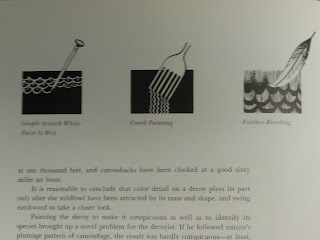The Art of the Decoy: American Bird Carvings by Adele Earnings with illustrations by Lou Schifferl
When I first got into decoy carving,
one of the first books I picked up on the subject
was The Art of the Decoy: American Bird Carvings
by Adele Earnest.
This is a solid starting point
for anyone interested in the subject of Decoys,
as well as early American folk art. 2 subjects
Mrs. Earnest seems very well versed in.
When the idea to post this poped in my head
it seemed fairly simple.
I'll share the art work I enjoy in an old book
maybe turn someone hip to it. But of course
I over thought it,wrote a few drafts like I was writing a paper for school.
So I'm Just gonna flip through it and give you my thoughts
on the guys art in a casual manner..
This is noway a slight to the author
of this wonderful book, she herself deserves a post of her own
but that's a topic
I need to look more into.
Before we get to the art, check out 'ol Mugsy here: Stumbling on a major archeological discovery while searching for bat shit(guano). That's right. People looking for bat shit found a cache of Native American decoys dating back to at least the last ice age. Eat your heart out yard sale combers! That beat up Mason factory mallard with an old repaint you got for $20 will never live up to this.

( a true American hero)
Now let's see some old hunting art. When you think of it, hunting art may be one of the oldest art forms. Paintings on European cave walls depict animals in those peoples environment, Which they no doubt relied on to survive. So that's an interesting thought. Though human's first art may be squiggles and geometric patterns our ancestors drew after eating the wrong (right?) kind of mushroom following grazing animal herds. If you believe that sort of thing..
Schifferl's art ranges from simple cross hatching to serious pieces that must've taken him hours to do. These geese flying in a snow storm is very effective. You can almost see their wings flap (or maybe that;s the wine), he really captures a moment in time with his work.
It's spring 1895, the sun begins to rise on the south shore of long island. The bay is strong in the air as an old salt of a man makes his way down the shoreline. Puffing on his pipe he shoulders a double barrel 12 gauge broken open on one shoulder. On his other a bag, shot gun shells rub against his wooden lures. These lures he whittled out of drift wood he found close to home with his old jackknife over long nights next to a warm fire. He finds his way to an old branch that drifted over from fire island after a storm. Smoke bellows from his pipe as he sticks them into the wet sand. A pair ring billed gulls make their passes looking for anything the tide brought in. The man goes to sit behind the brittle branch and waits. and waits taking in the beauty of the blazing sun climbing into the early morning sky.
Before long he see's his prey, a flock of yellow legs flying out from the marsh like a swarm of locust. He whistles, trying to make the sound these beach birds make. They make their pass seeing what seems to them, their buddies feeding on small crustaceans in the surf. before they know what hit them the hunter hops up and fires 2 quick shots into the dark mass frying by him. 20-30 birds drop to the beach as he stumbles reloading.
That's not in the book, but that's the impression I get looking at this.
Mr. Schifferl’s work is top notch. A few books I own on the subject of decoys also include line drawings similar to his, however the way Schifferl frames scenes no doubt common along the Eastern seaboard in the late 19th century is really something that deserves mention.
Me, never seeing many of the birds I carved, wished I saw something like this early one. I never realized how large curlews where.
I really appreciate how this guy draws water. If you've never tried,
go ahead. draw a choppy bay and see how i comes out.
I like how the artist depicted the tools of the trade wen it comes to painting.
Even if it's as basic as a fork to scratch paint.
Back to the birds....
ah, the height of lady's fashion.....
In case you can't make it out, that's a dead bird on her hat.
I believe I've read Terns where a popular choice of hat decoration in some social circles...



























Comments
Post a Comment